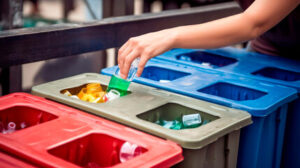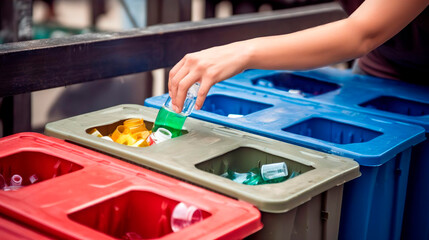Waste disposal is a global issue that has become a serious concern due to excessive waste production. It is essential to use products and reduce the waste produced judiciously.
Clinical, research, service, maintenance, and cleaning operations produce chemical, biological, recyclable, and radioactive waste materials. These wastes must be managed by personnel (“generators”) using the relevant waste management procedures. Visit Website to learn more.

The importance of reuse in waste disposal can not be overemphasized. It reduces the amount of waste that is disposed of and encourages creativity and resourcefulness. It also helps businesses to save money on material costs and to become more environmentally responsible. In addition, reusing items can help to promote a positive image for the company.
Reuse involves transforming used products and materials into new ones through industrial processing. This process eliminates the need for new raw materials, which would otherwise be sourced from nature. It is one of the three R’s in the waste management hierarchy, along with reduction and recycling.
Most countries have laws requiring their citizens to recycle and to use recycled goods. This practice prevents the accumulation of garbage and reduces pollution. However, some types of waste are unable to be recycled. Such wastes are usually buried in landfills or are dumped in the ocean, where they can damage aquatic life. The international community is trying to find a better way to dispose of this toxic waste.
In the developed world, most waste is collected and transported to special disposal plants. This is often done using a system called curb-side collection, in which waste is collected from homes and businesses by specialised trucks. In rural areas, waste is deposited at a local transfer station.
Reusing items reduces the amount of waste that is discarded, and it can also save energy. For example, reusable plastic bags can be reused for grocery shopping and repurposed as cleaning cloths. Old paper can be used as notepaper or a scratch pad, and repurposed aluminum foil and glass containers can be used for food storage. In addition, it is important to unplug appliances like fans and microwaves when they are not in use, as these drain energy.
Companies can also save money on waste disposal by reusing industrial materials and products that are no longer useful to them. This is referred to as “materials exchange.” This type of program matches industrial waste generators with other companies that require the same materials. The companies may contact each other directly or through an exchange service.
Recycling is an important part of waste disposal. It helps reduce the amount of garbage that is sent to landfills and conserves natural resources. It also saves energy and creates jobs. It is an essential component of the three Rs: reduce, reuse, and recycle. In addition, it protects animals and plants. It also keeps them safe from pollution and climate change. Recycling helps reduce greenhouse gas emissions, which contribute to global warming and ozone depletion. It also reduces the need to cut down trees or drill for raw materials. This in turn saves wild animals from losing their habitats and prevents them from becoming endangered or dying of starvation.
During recycling, the waste is converted into products that can be used again. This includes paper, glass, aluminum, and plastics. These products can be made into other goods such as park benches, carpeting, and asphalt. Many manufacturers, including cell phone and computer companies, are now using recycled materials in their products. This is known as closed loop recycling.
The most important benefit of recycling is that it is cost-effective. It reduces the need to source new raw materials, which cuts down on the price of production and the energy used for production. This, in turn, reduces the environmental impact of manufacturing and saves money for both consumers and businesses. It also provides a stable supply of raw materials for the economy.
Recycled materials are also used to produce a variety of different types of products, from construction to electronics to apparel. They are often sold in bulk to recycling plants, which transform them into raw materials that can be used for other products. Unlike virgin raw materials, recycled raw materials are environmentally friendly and do not require a lot of energy to process.
Despite its many benefits, recycling is not a panacea. Its effectiveness depends on reducing the amount of waste that is generated in the first place, which is best achieved through source reduction. This is done through a number of methods, including reducing the quantity of items purchased or reusing existing items. It also involves changing the design of products and educating people to make wise purchasing decisions.
A landfill is the most basic form of waste disposal. It is a site where trash from homes, businesses and industrial plants is collected and deposited. It is the least desirable option in a hierarchy of waste disposal because it degrades and releases toxins into the environment. However, it is a necessary part of the waste management process. Today’s landfills are sophisticated, engineered structures built into or on the ground.
Modern landfills are complex structures that, when properly operated and maintained, protect the environment. They are constructed with several layers of materials that separate the waste from the surrounding soil and water.
The bottom layer is a liner made of clay or synthetic material that prevents liquid from seeping into the surrounding soil. The next layer is a drainage system, which is designed to detect and remove any leaks that might occur. A second liner, which consists of at least two feet of natural low-permeability clay or a synthetic material, is placed on top of the drainage layer.
On the sides of the landfill, a layer of compacted soil is applied to help contain the waste and reduce the risk of contamination of local groundwater. A tarp is then placed over the garbage to protect it from rain and sunlight, which can cause odors and promote the growth of microorganisms that are harmful.
As the waste breaks down, it creates methane gas, which escapes into the atmosphere. This is a major problem for landfills because methane is a potent greenhouse gas that contributes to global warming. To mitigate this problem, some modern landfills are designed with a gas collection system that captures and vents methane into the air or uses it as an energy source.
Other problems are associated with landfills, including fire hazards, which are common in older landfills. They are also a breeding ground for pests, such as rodents and insects, which can spread diseases to humans and other animals. Some landfills are contaminated with hazardous waste, such as polychlorinated biphenyl (PCB), which is an extremely toxic chemical. To avoid such contamination, many states have enacted laws to restrict the locations where PCB-contaminated waste can be stored or transported.
All buildings in a city generate waste, and it is important that garbage is properly collected and stored for disposal. Whether it is burned in an incinerator or buried in a landfill, the proper disposal of waste is vital for the health of humans and the environment. The accumulation of waste poses several problems, including land pollution, water pollution, and environmental degradation. These problems can be caused by domestic, commercial, industrial, and municipal wastes.
Garbage that is left unattended can attract flies and rodents, which then spread bacteria to people. This is especially dangerous when the waste is deposited near water sources. If the waste is dumped in a river or other body of water, it can cause eutrophication, which reduces oxygen levels and kills aquatic life.
While landfills are still used in many countries, they are increasingly being replaced by alternative methods of waste disposal. Landfills release methane, which is a greenhouse gas that traps heat in the atmosphere and contributes to global warming. This is a significant problem for the planet, and many cities are trying to find better ways of disposing of waste.
Some cities use vacuum collection systems that take waste from residential or business properties and transport it to a central location for disposal. These systems are popular in However, they can cause a variety of occupational health issues, such as hepatitis B virus infection among waste collectors.
Waste disposal is an important issue for everyone in the world, and it is essential to find a solution that works for both the environment and humans. It is also crucial to encourage reuse and recycling, which are much more sustainable than the use of landfills or open burning. This way, we can continue to enjoy the beauty of our planet while preserving its natural resources.
